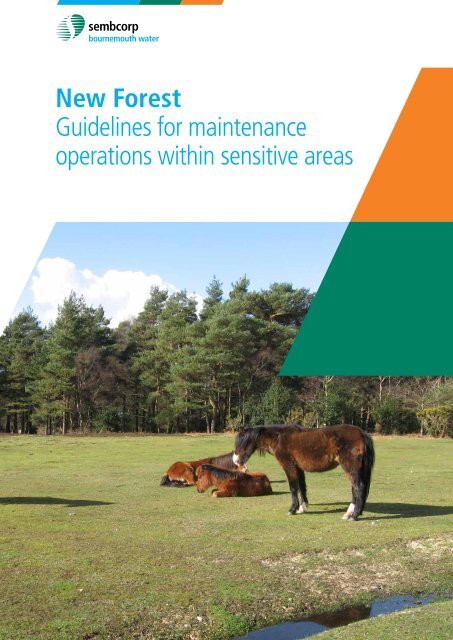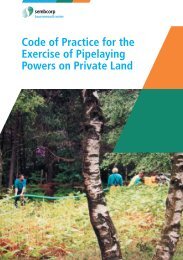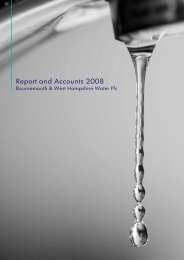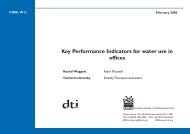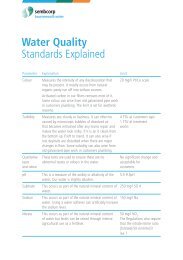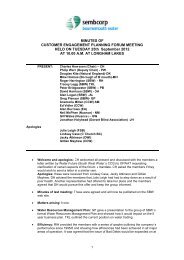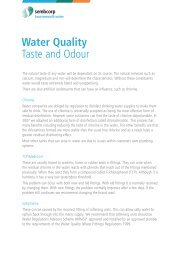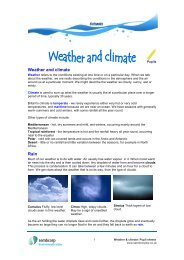New Forest - Sembcorp Bournemouth Water
New Forest - Sembcorp Bournemouth Water
New Forest - Sembcorp Bournemouth Water
- No tags were found...
You also want an ePaper? Increase the reach of your titles
YUMPU automatically turns print PDFs into web optimized ePapers that Google loves.
2. Introduction and scope<strong>Sembcorp</strong> <strong>Bournemouth</strong> <strong>Water</strong> is committed to its environmentalobjectives as set out in the company environmental policystatement, which states that we will manage our activities andassets to protect and improve habitat and increase biodiversity.This model agreement and specification for implementingworks will enable <strong>Sembcorp</strong> <strong>Bournemouth</strong> <strong>Water</strong> to meet theseobjectives when carrying out routine maintenance in the <strong>New</strong><strong>Forest</strong>.The overriding aim of this document is to develop a commonunderstanding between the organisations, develop aspecification for all to sign up to for implementing works in the<strong>New</strong> <strong>Forest</strong> area, and to work in partnership in achieving theaims and objectives of both organisations. This approach willallow for closer and more efficient working.This document provides a clear working framework to dealwith both planned and emergency maintenance operationson designated land. The document identifies the procedureswhich have potential to damage the environment and agreesworking methodologies for routine maintenance operations tominimize the impact on the environment. It sets out expectationsand informative notes for emergency procedures and the wayin which Natural England and <strong>Sembcorp</strong> <strong>Bournemouth</strong> <strong>Water</strong>should interact over major schemes. These agreed procedureswill protect and enhance biodiversity while improving,maintaining and operating the supply network. In addition,<strong>Sembcorp</strong> <strong>Bournemouth</strong> <strong>Water</strong> is committed to carryingout additional positive work to further conservation andenhancement of habitat wherever possible.The document identifies the specific nature conservation interestfeatures within the <strong>New</strong> <strong>Forest</strong> SSSI, SAC, SPA and Ramsar site.It lists the objectives for the management of those features,describes the objectives for management and summarisesagreed joint Natural England and <strong>Sembcorp</strong> <strong>Bournemouth</strong><strong>Water</strong> objectives. It describes the issues and the legislativeframework and processes involved in its management. Thetypes of operational works are described together with theagreed procedures and programmes. Finally the managementrequired to restore the site to favourable condition for natureconservation is described.3. Key contactsOther than <strong>Sembcorp</strong> <strong>Bournemouth</strong> <strong>Water</strong> and Natural England,the model agreement and specification applies to all contractorsworking on behalf of <strong>Sembcorp</strong> <strong>Bournemouth</strong> <strong>Water</strong>.This agreement must be understood and accepted throughoutthe hierarchy of each organisation through continuous dialogueand liaison.<strong>Sembcorp</strong> <strong>Bournemouth</strong> <strong>Water</strong>REGISTERED OFFICE George Jessel HouseFrancis Avenue, <strong>Bournemouth</strong>, BH11 8NXTel (44) 01202 591111Natural EnglandHampshire and Isle of WightCromwell House, 2nd Floor15 Andover Road, Winchester , SO23 7BTTel (44) 0300 060 25144. Natural EnglandNatural England works to ensure that the use and managementof the natural environment is more sustainable. It bringstogether advice and funding to promote farming and landmanagement practices that benefit wildlife and encouragebiodiversity.Natural England is working to enhance biodiversity, landscapesand wildlife in rural, urban, coastal and marine areas; promoteaccess, recreation and public well-being, and contribute to theway natural resources are managed so that they can be enjoyednow and by future generations.Natural England has responsibilities for conserving andenhancing the marine and coastal environment and forpromoting its sustainable use and opportunities for publicenjoyment. Work includes monitoring marine protected areasand creating new ones, working to improve coastal and marinebiodiversity and working with government on the Marine Bill.All company and contract staff are required to attend ashort awareness seminar with the company EnvironmentalPerformance Manager.5. Nature conservation importanceThe <strong>New</strong> <strong>Forest</strong> SSSI, SAC, SPA and Ramsar is one of the mostimportant sites for wildlife in the UK and is of exceptionalimportance for nature conservation. It supports a complexmosaic of wildlife habitats including unique habitats and refuges(see appendices A-D).The <strong>New</strong> <strong>Forest</strong> embraces the largest area of ‘unsown’vegetation in lowland England and includes the representationon a large scale of habitats formerly common but nowfragmented and rare in lowland western Europe. The intimatemosaic of habitats owes much to the local geology andtraditional commoning grazing system, a situation which isuncommon in lowland England. The habitats include lowlandheath, valley and seepage step mire or fen and ancient pasturewoodland, including riparian and bog woodland. Nowhere elsedo these habitats occur in combination and on so large a scale.Within the matrix of habitats are pasture woodland and scrubdominated by oak, beech and holly; heathland and associatedgrassland; wet heath, valley mire-fen and plantations datingfrom various periods since the early 18th century and a range ofacid to neutral grasslands.The <strong>New</strong> <strong>Forest</strong> contains the most extensive areas of activewood-pasture in north west Europe comprising mature, seminaturalbeech, which represent Atlantic beech forests in themost southerly part of the habitat’s range, together with oldoak. This mosaic, with other types of woodland and heath, hasallowed unique and varied assemblages of epiphytic lichens and2 <strong>New</strong> <strong>Forest</strong> – Guidelines for maintenance operations within sensitive areas
saproxylic (dead wood) invertebrates – in particular the stagbeetle, to be sustained in situations where the woodland is openand the tree trunks receive sunlight.Occasionally in wet hollows, birch – willow stands occurover valley bog vegetation, with fringing alder – Sphagnumstands where there is some water movement. These stands ofbog woodland appear to have persisted for long periods instable association with the underlying Sphagnum bog-mosscommunities. The rich epiphytic lichen communities and pollenrecord provide evidence for the persistence of this association.The forest also contains many streams and small rivers someof which are less affected by drainage and canalisation thanthose in any other comparable area in the lowlands of England.Associated with many of the streams, particularly those withalkaline and neutral groundwater, are areas of alder woodlandwhich collectively form an extensive resource with a rich flora.In places there are examples of transitions from open waterthrough reedswamp and fen to alder woodland. In other placesthere are transitions to oak woods and beech forests with hollyand sometimes yew in the shrub layer.The site contains the most extensive stands of lowland northernAtlantic wet heaths in southern England, mainly of the Ericatetralix – Sphagnum compactum type; Schoenus nigricans –Narthecium ossifragum mire is also found on this site. The wetheaths are important for rare plants, such as marsh gentian andmarsh clubmoss and a number of dragonfly species, includingthe scarce blue-tailed damselfly, southern damselfly and smallred damselfly.The largest area of lowland dry heathland in the UK is alsofound in the forest. It is particularly important for the diversityof its habitats and the range of rare and scarce species itsupports. The dry heaths of the <strong>New</strong> <strong>Forest</strong> comprise two maincommunities; the Calluna vulgaris – Ulex minor heath type,and Ulex minor – Agrostis curtisii heath type. There are a widerange of transitions between dry heath and wet heath, Moliniagrassland, fen, acid grassland and various types of scrub andwoodland. The <strong>New</strong> <strong>Forest</strong> Molinia meadows are unusual inthe UK in terms of their species composition and management.The heathy form of Molinia caerulea – Cirsium dissectum fenmeadowoccurs in areas of heavy grazing by ponies and cattle inareas known locally as ‘lawns’, often in a fine-scale mosaic withwet heaths and other mire and grassland communities. Theselawns occur on flushed soils on slopes and on level terrain onthe floodplains of rivers and streams. The grasslands are speciesrich,and particular features are the abundance of small sedgessuch as carnation sedge, common sedge and yellow-sedge,oedocarpa and the more frequent occurrence of mat-grass andpetty whin compared to stands elsewhere in the UK.The dry heath communities are one of the European interestfeatures for which the <strong>New</strong> <strong>Forest</strong> is designated as a SAC. At theeastern end there are smaller areas of former pasture woodlandwhich although no longer grazed, retains characteristicstypical of the habitat such as mature beech and oak with hollyunderstorey with long established lichen and moss communities.These relatively undisturbed grass and heathland areas areimportant refuges for a range of small mammals and reptiles.Of the six species of native reptiles occurring in the <strong>New</strong> <strong>Forest</strong>,(adder, grass snake, smooth snake, common lizard, sand lizard,and slow worm) only smooth snake and sand lizard are confinedto heathland habitats. The smooth snake is less demanding inhabitat requirements than sand lizard, utilising the full range ofdry and wet heath communities and is far more widespread andbetter able to cope with open forest heathland managementregimes. All the reptiles have some protection under UKlegislation. Smooth snake populations and their habitat arefurther protected through European legislation.Hatchet Pond and associated ponds are examples of oligotrophic(nutrient poor) waterbodies amidst wet and dry lowland heathdeveloped over fluvial deposits. It contains shoreweed andisolated populations of northern species such as bog orchidand floating bur-reed, alongside rare southern species suchas Hampshire-purslane. This pond is important as a southernexample of this lake type where northern species more commonin the uplands of the UK, co-exist with southern species.The site also contains nutrient poor vegetation on the edge oflarge temporary ponds, shallow ephemeral pools and poacheddamp hollows in grassland, which support a number of specialistspecies in a zone with toad rush. These include the twonationally scarce species coral-necklace and yellow centaury,often in association with allseed and chaffweed. Continuousgrazing pressure is of prime importance in the maintenance ofthe outstanding flora of these temporary pond communities.Temporary ponds occur throughout the forest in depressionscapable of holding water for part of the year. Most ponds aresmall (between 5-10m across) and although great in number,amount to less than 10ha in total area. Many of these containgreat crested newt.6. <strong>Sembcorp</strong> <strong>Bournemouth</strong> <strong>Water</strong> aims andobjectives<strong>Sembcorp</strong> <strong>Bournemouth</strong> <strong>Water</strong> is responsible for operating andmaintaining a public water supply network to approximately halfa million people in southern England. <strong>Sembcorp</strong> <strong>Bournemouth</strong><strong>Water</strong>’s objective is to supply an adequate quantity ofwholesome drinking water while meeting all of the associatedlegal obligations and do so in an environmentally sustainablemanner in support of the local economy.<strong>Sembcorp</strong> <strong>Bournemouth</strong> <strong>Water</strong> is keen to ensure a moreeffective delivery through better working relationships with allits stakeholders and is fully aware of the impact its operationshave on the community in general. It is committed to theISO 4001 environmental management system that it has inplace. <strong>Sembcorp</strong> <strong>Bournemouth</strong> <strong>Water</strong> is a statutory undertakerof the Wildlife and Countryside Act and NERC Act (see 9.2,9.5). Working with Natural England to support delivery of thefavourable condition of the SSSI is just one example.<strong>Sembcorp</strong> <strong>Bournemouth</strong> <strong>Water</strong> recognises the need to maintaina balance between effective operation of the supply network forcommercial needs and the environmental impact of operationand maintenance of the 2750km of water main and associatedfittings within its distribution network.<strong>New</strong> <strong>Forest</strong> – Guidelines for maintenance operations within sensitive areas 3
As a matter of policy, Ramsar sites in England are protected asEuropean sites as set out in The Conservation of Habitats andSpecies Regulations 2010 (SI No. 2010/490). The vast majorityare also classified as SPAs and all terrestrial Ramsar sites inEngland are also notified as Sites of Special Scientific Interest(SSSIs).Under this legislation, a competent authority, before decidingto undertake, or give any consent, permission or otherauthorisation for a plan or project which:a. is likely to have a significant effect on a European siteor a European offshore marine site (either alone or incombination with other plans or projects), andb. is not directly connected with or necessary to themanagement of that site,must make an appropriate assessment of the implications forthat site in view of that site’s conservation objectives.9.8 Protected speciesConservation legislation covers certain individuals in additionto particular wildlife habitats and geological sites. Species maybe protected under the W&CA as amended by CRoW 2000 andsome are protected under the Conservation of Habitats andSpecies Regulations 2010, these being referred to as Europeanprotected species. All six species of protected native reptilesoccur in the <strong>New</strong> <strong>Forest</strong>; adder, grass snake, smooth snake,common lizard, sand lizard and slow worm which are protectedby a range of national and/or European legislation. Amphibiansare also afforded protection; the great crested newt is protectedby European legislation. Several bat species occur in the <strong>New</strong><strong>Forest</strong> and all are protected under European legislation. Badgersalso occur and are protected under national legislation.Those likely to be found within the <strong>New</strong> <strong>Forest</strong> include thefollowing, but please note this list is not exhaustive and if indoubt further advice should be sought from Natural England.9.8.1 Sand lizard, smooth snake and great crested newtThese are European protected species and are protected against:■ intentionally, recklessly or deliberately killing,■ injuring or taking (capture etc), possession■ disturbance and destruction of breeding, resting andsheltering places■ sale, barter, exchange, transporting for sale and advertisingto sell or to buysand lizard (Lacerta agilis)smooth snake (Coronella austriaca)Great crested newt (Triturus cristatus)6 <strong>New</strong> <strong>Forest</strong> – Guidelines for maintenance operations within sensitive areas
9.8.2 Common lizard, slow worm, grass snake and adderThese are protected against:■ intentionally or recklessly killing■ injuring and trade (sale, barter, exchange, transporting forsale and advertising to sell or to buy)9.8.3 Smooth newt, palmate newt, common frog andcommon toadThese are protected against:■ trade (sale, barter, exchange, transporting for sale andadvertising to sell or to buy)common lizard (Lacerta viripara)smooth newt (Lissotriton vulgaris)slow worm (Anguis fragilis)palmate newt (Lissotriton helveticus)grass snake (Natrix natrix)common frog (Rana temporaria)adder (Vipera berus)common toad (Bufo bufo)<strong>New</strong> <strong>Forest</strong> – Guidelines for maintenance operations within sensitive areas 7
9.8.4 All bats and their roostsThese are European protected species and are protected againstintentionally, recklessly or deliberately killing, injuring or taking(capture etc), possession, disturbance, damage,destruction orobstruction of breeding, resting and sheltering places, includingbat roosts and known hibernacula – if bats are present or not,sale, barter, exchange, transporting for sale and advertising tosell or to buy. (See Appendix E for detailed guidance).management and other works to avoid killing, injuring ordisturbance to protected species is crucial.Essential maintenance operations which are likely to causedisturbance or worse must be planned and designed withspecies protection properly integrated and costed. As a minimumthis will involve careful preliminary searches of known reptilesites by experienced and appropriately licensed specialists.Where works cannot proceed without disturbance then specialmeasures must be put in place to accommodate the speciesinterests. This will be subject to individual design plans involvingfull consultation and approval with Natural England.Daubenton’s bat (Myotis daubentoni)9.8.5 BadgersBadgers are protected under separate legislation (Protection ofBadgers Act 1992) against wilful killing, injuring, taking (captureetc), possession and to cruelly ill-treat or attempt to do so andto intentionally or recklessly interfere with, damage, destroy orobstruct access to a sett and disturb badgers whilst they areoccupying a sett.badger (Meles meles)9.8.6 ExceptionsAn important defence to any prosecution that might be broughtis the exception that where the killing, injuring or taking,disturbance and destruction of breeding, resting and shelteringplaces, has occurred inadvertently as an incidental result ofa lawful operation by an authorised person (ie the owner oroccupier or any person authorised by the owner or occupier),no offence has been committed. All recognised forest andheathland management operations are lawful and althoughthese can be carried out at times of year when reptiles (inparticular) are vulnerable, the spirit of the Act is clear – theneedless and deliberate destruction of protected species isunacceptable and the onus is on the operator to carry outoperations in a reasonably sensitive way. Planning of habitat10. IssuesThe <strong>New</strong> <strong>Forest</strong> is of international importance for natureconservation and its protection and management is subject tonational and European legislation.■ <strong>Sembcorp</strong> <strong>Bournemouth</strong> <strong>Water</strong>’s key objective with regard tothe environment is to minimise the impact of the network onboth the natural and built environment.■ Agreed procedures should be developed between allparties to protect and enhance biodiversity and the natureconservation interest while improving, maintaining andoperating the network.■ Management plans for all <strong>Sembcorp</strong> <strong>Bournemouth</strong> <strong>Water</strong>landholdings within the <strong>New</strong> <strong>Forest</strong> have been developed tomaximise biodiversity and protect and enhance habitat.11. Protocol agreement for planned works withinsensitive areasThis section lays out the tasks undertaken by <strong>Sembcorp</strong><strong>Bournemouth</strong> <strong>Water</strong> and its contractors on a routine orprogrammed basis. The protocol agreement for planned worksapplies to <strong>Sembcorp</strong> <strong>Bournemouth</strong> <strong>Water</strong> direct labour, termcontractor and any operative working on behalf of <strong>Sembcorp</strong><strong>Bournemouth</strong> <strong>Water</strong>.Consideration during the planning process should be made tothe following:■ All bat species and their roosts are fully protected in Britain,advice regarding bats and trees through Natural England’sguidance note should be taken (Appendix E). Please notethat if bats or evidence of bats are found at anytime then allworks must stop immediately and Natural England contactedfor further guidance.■ All British birds, their nests and eggs are protected in law.To reduce the likelihood of harm to breeding birds, clearanceof trees and areas of scrub should avoid the bird breedingseason, contact Natural England for further guidance.■ Protected species likely to be found within sensitive arease.g. reptiles contact Natural England for further guidance.In all cases the location and route of the proposed works willbe assessed to avoid unnecessary impact within any designatedsensitive area and the immediate area surrounding the site.8 <strong>New</strong> <strong>Forest</strong> – Guidelines for maintenance operations within sensitive areas
If the proposed works fall within a sensitive area, <strong>Sembcorp</strong><strong>Bournemouth</strong> <strong>Water</strong> will refer to the protocols set out in theoperation activity and notification guide (Appendix I), andwill make contact as early as possible with Natural Englandif required, followed by the landowner and any other partiesthat Natural England subsequently feels should be informed. Alocation plan and confirmation of the extent of proposed works,incorporating dates, duration and materials will be submitted toNatural England for information and their records.Natural England should make known any exceptionalconditions or detailed site specific advice which is notcovered within the general methodology for pipe layingwithin sensitive areas. A site meeting will be organised ifrequired by Natural England and any other relevant parties.Alternative pipe laying options (no dig technology) mayneed to be considered for site specific locations in orderto minimise any disturbance of the ground surface and itsvegetation.11.1 Pipe and cable layingThe purpose of this method of working statement is to informall 28G authorities, owner/occupiers and their contractors of thecare that must be taken when carrying out operation or workson SSSI, SPA, SAC and Ramsar sites in view of their ecologicalimportance and their national and international protection.Excavation and reinstatement■ All materials excavated shall be carefully lifted and storedseparately in the correct order according to turf/vegetation,topsoil and subsoil.■ All materials are to be stored on Terram or similar sheetingto protect the vegetation and ground underneath andprevent it from drying out.■ Excavated material is not to be placed in adjacent ditchesor on adjacent banks (note: these are particularly importantecologically and must not be disturbed).■ In digging any trench in a road or track, excavated materialwill be contained within the boundary of the track at alltimes and not be permitted to spill onto the vegetationeither side.■ Care should be taken when excavating within or underany tree canopy adhering to National Joint Utilities Group(NJUG) guideline no.10 (available from the NetworkMaintenance dept). Excavations within or under the canopyof trees shall be made using handtools only. Care should betaken to ensure that tree roots are not cut or injured.■ All excavations will be barriered and suitably guarded duringthe pipe laying works and when left unattended to protectcommoners’ stock and members of the public from injury.■ All materials excavated shall be returned to the positionfrom which it was taken in the correct order and restored toits original profile.■ Any excavation is to be thoroughly compacted onreinstatement to minimise settlement. Any defects apparent2 years after the excavated materials were replaced willbe repaired and made good by the 28G authority or theircontractors.■ Vegetated turf to be reinstated and allowed to recovernaturally■ Any seeding required will be in accordance with NaturalEngland and the land owner. If re-seeding of disturbed landis to be carried out a locally sourced grass seed mixture thatis locally agreed/approved shall be used.11.2 Protocol agreement for planned works within sensitiveareas■ A full schedule of the condition of the working area beforeworks begin will be made, this may consist of (any or allof) photographs, written notes and video footage and willbe kept on file for future reference. A further schedule ofthe area will be made three months from completion of theworks.■ <strong>Sembcorp</strong> <strong>Bournemouth</strong> <strong>Water</strong> will carry out operations insuch a way and at such a time as to minimise the damageas reasonably practical to the sensitive area. This will includerestricting vehicle movements within the sensitive area. Staffand contractors must be informed of the need to keep trafficmovements to a minimum.■ Only emergency work will be undertaken within the sensitivearea when the ground is waterlogged and no unnecessaryvehicles are to be used.■ Machinery will be confined to the barriered area along theroute of the proposed works.■ Any fuel/diesel required will be stored securely and correctlybunded in the event of it being required long term.■ Storage of materials will be within a protected/barrieredarea or kept offsite. Any materials or equipment placedon the land temporarily shall be kept in a neat and tidycondition and safe to any stock or wild animals.v All pipe left unattended will be capped to ensure theintegrity and security of the fitting and maintain thesafekeeping of the sensitive area.■ All manhole covers or other accessories installed shall bepositioned so as not to stand proud of or above the naturallevel of the adjacent or surrounding land.■ All mechanical equipment will be in good working order andfree from any oil/hydraulic leaks.■ Guidelines for working near or across watercourses/streamsshould be followed to avoid contamination during the works(see Appendix F). Advice and consent should be obtainedfrom the Environment Agency.■ All ditches or streams will be crossed by laying the pipe ata minimum depth of one metre beneath the ditch bed andoverlaying with concrete.■ Upon completion of the works to leave the land in thecondition originally found. Any barriers, dragon’s teeth or carfree area ditching that is removed or disturbed during thecourse of the works shall be reinstated and made good.<strong>New</strong> <strong>Forest</strong> – Guidelines for maintenance operations within sensitive areas 9
AppendicespageAppendix A: SSSI citation 12Appendix B: SAC citation 15Appendix C: EC Directive 79 409 – SPA 17Appendix D: Ramsar 17Appendix E: Bats and trees 19Appendix F:EA guidelines for working near or acrosswatercourses 20Appendix G: Process water with use of siltbuster 23Appendix H: Overview of how to use protocol –guide for staff 23Appendix I:Operation activity and permissionsneeded 24Appendix J: Risk assessment 24Appendix K: Notification form for works 25Appendix L:Example of notification of emergencyworks 25<strong>New</strong> <strong>Forest</strong> – Guidelines for maintenance operations within sensitive areas 11
Appendix A: SSSI citationCounty: Hampshire/WiltshireSite Name: <strong>New</strong> <strong>Forest</strong> SSSIStatus: Site of Special Scientific Interest (SSSI) notified underSection 28 of the Wildlife and Countryside Act 1981Local Planning Authority: Hampshire County Council, <strong>New</strong><strong>Forest</strong> District Council, Wiltshire County Council, SalisburyDistrict Council, Test Valley Borough CouncilNational Grid Reference: SU 298081Ordnance Survey Sheet 1:50,000: 195, 196 1:25,000: SU 10,11, 20, 21, 30, 31, 40, SZ 29, 39Area: 28,947.37 (ha) 71,528.95 (ac)Date Notified (Under 1949 Act): 1959, 1971, 1974Date of Last Revision: 1979Date Notified (Under 1981 Act): 7 May 1987Date of Previous Revision: 1987Date of Last Revision: 28 February 1996Date Confirmed: 14 November 1996Other Information:The <strong>New</strong> <strong>Forest</strong> is classified as a Grade 1 site in ‘A NatureConservation Review’ edited by D. A. Ratcliffe (CambridgeUniversity Press, 1977) and includes seven GeologicalConservation Review sites. The major part of the site has beendesignated as a Special Protection Area under the EC Directive79/409 on the Conservation of Wild Birds and as a Ramsar Siteunder the Ramsar Convention on Wetlands of InternationalImportance. The site is mainly Crown Land together with themanorial wastes of Plaitford, Furzley, Half Moon, Cadnam, HalePurlieu and Hightown Commons belonging to the National Trust;Hyde and Gorley Commons and parts of Rockford and Ibsleyowned by Hampshire County Council; the rest of Rockford andIbsley Commons, Minstead Manor, Kingston Great Common,Bisterne Common, West Wellow and Copythorne Common andmost of the unimproved meadows are privately owned. Partof Kingston Great Common is a National Nature Reserve andthere are three reserves managed by the Hampshire WildlifeTrust at Bagnum, Long Aldermoor and Holmsley. The CrownLand is managed by the <strong>Forest</strong>ry Commission on behalf of theMinister of Agriculture. The Court of Verderers have statutorypowers within the <strong>Forest</strong> although they own very little land andno domestic stock. The <strong>Forest</strong>ry Commission, along with theVerderers, and English Nature have signed a Minute of Intentwhich provides for the participation of English Nature in thepreparation of management plans and consultation over annualmanagement programmes. Selected areas were notified in 1959and a much larger area in 1971. Further additions were made in1974, 1979 and 1987.Reasons for Notification:The <strong>New</strong> <strong>Forest</strong> embraces the largest area of ‘unsown’vegetation in lowland England and includes the representationon a large scale of habitat formations formerly common butnow fragmented and rare in lowland western Europe. Theyinclude lowland heath, valley and seepage step mire, or fen, andancient pasture woodland, including riparian and bog woodland.Nowhere else do these habitats occur in combination and onso large a scale. There are about 4,600 hectares of pasturewoodland and scrub dominated by oak, beech and holly; 11,800hectares of heathland and associated grassland; 3,300 hectaresof wet heath and valley mire-fen and also 8,400 hectares ofplantations dating from various periods since the early 18thcentury. Within this matrix of habitats are a range of acid toneutral grasslands where the vegetation owes much to the localgeology and continuous grazing, a situation which is uncommonin lowland England. Scattered around the <strong>New</strong> <strong>Forest</strong> andthroughout the small pockets of enclosed farmland are a seriesof unimproved meadows which have similarities with theseOpen <strong>Forest</strong> grasslands.A network of small streams draining the system form an unusualcommunity which results from the combination of nutrient-poor,acid waters and outcrops of neutral enriched soils.There are many ponds of varying sizes and water chemistryincluding several ephemeral ponds. This wide range of habitatssupport an assemblage of nationally rare and scarce plantsand a nationally important assemblage of rare and scarceinvertebrates. The area supports internationally importantbreeding populations of certain bird species and the winteringpopulation of another as well as an assemblage of birdsassociated with specific habitats such as old woodland orwetlands. Within the <strong>New</strong> <strong>Forest</strong> there are seven sites which areof special geological or physiographic interest including valleymires, the headwaters of the Highland <strong>Water</strong>, stream sectionswith exposures of fossil-bearing strata and a gravel pit rich inpalaeolithic artefacts.The <strong>New</strong> <strong>Forest</strong> is probably sufficiently large to ensure thelong term survival of the characteristic flora and fauna withinthe wide range of habitats. Smaller isolated examples of thecomponent habitats are vulnerable to biological impoverishmentbut here in the <strong>New</strong> <strong>Forest</strong> has survived largely because of thepersistence of a pastoral economy based on the exercise ofcommon rights of grazing and mast together with protectionafforded by Crown ownership. This, and the management ofvegetation in the Open <strong>Forest</strong> through burning and cuttingprogrammes, administered by the <strong>Forest</strong>ry Commission on theCrown Lands, maintains the quality of the grazings, ensures theprevention of natural succession and encourages local diversityin plant communities. The pastoral economy in turn depends onthe continued existence of a small community of commonerswho make up a discrete social unit and this combination ofnatural and cultural elements contributes to the maintenance ofthe <strong>New</strong> <strong>Forest</strong> habitats.Geomorphologically the <strong>Forest</strong> comprises a series of erodedterraces capped with flint gravel, brickearth and other superficialdeposits. The terraces are highest and most fragmented byerosion in the north and lowest and most complete in the south.Erosion has exposed the underlying Tertiary strata, in widevalleys and hollows separating the terraces. Soils are mainlyacid, poor in nutrients, susceptible to leaching and only slowlypermeable. Locally, however, there are enriched areas such asthe exposed Headon Beds in the south which support relativelyspecies-rich grassland or mire floras. The <strong>Forest</strong> streams, miresand abundant wet flushes along slope springlines help to create12 <strong>New</strong> <strong>Forest</strong> – Guidelines for maintenance operations within sensitive areas
a humid microclimate which, in the woodlands in particular,provides the right conditions for epiphytic lichens, bryophytesand ferns, a situation which has become rare elsewhere.The unenclosed woodlands are dominated by oak and beech invarying proportions. Oak is generally dominant on the heaviersoils, and some areas comprise nearly monospecific oakwoods,whereas the beech tends to dominate on sandy knolls andwell drained terrace edges. Holly is the dominant shrub layerspecies. The number of tree species is higher in linear riverinewoodland where ash is abundant and carr of alder, sallow andholly are common. Age structure of the woodland is closelyrelated to past fluctuations in herbivore densities. The oldestgeneration of trees still standing are oaks and beeches of early17th century origin. A high proportion of these and later 17thcentury trees are pollarded. The main younger generationshave arisen since about the mid 19th century. Older treessupport the richest known woodland lichen flora in lowlandEurope, and an exceptionally species-rich deadwood fauna,mainly beetles Coleoptera, including the stag beetle Lucanuscervus and now rare in Europe, and flies Diptera. The lichenflora includes two rare species, Catillaria laureri and Parmeliaminarum (Sch.8)**. The woods are also rich in fungi that arespecific to pasture woodland such as Hericium erinaceous,Mycena picta, Creolophus circhatus and Flammulaster limulata.The woodland ground flora varies according to soil type butgrazing often gives the impression of it being impoverished. Onbase-rich soils, however, species diversity increases with grazingwhereas on more acid soils the vascular plants may be reducedbut bryophytes become more extensive and diverse. Woodlandspecies such as Dicranum majus, Rhitidiadelphus loreus andLeucobryum juniperoideum can be common whilst rarer speciesinclude Bassania trilobuta and Saccogyna viticulosa. The vascularplants include about 60 species associated with old woodland.These older trees also support a high density of holenesting,insectivorous birds, such as redstart Phoenicurus phoenicurus,and provide roost sites for several species of bat including thevery rare Bechstein’s bat Myotis bechsteini**The sylvicultural enclosures include 40% broad-leaved trees,mainly oak and beech, which, with the unenclosed woods,comprises the largest tract of native broad-leaved woodlandin southern England. The inclosures include many fragments offormer pasture woods totalling about 285 hectares and theseare relatively unmodified by enclosure. Much of the remainingbroad-leaved component comprises mature oak plantationwhich when in proximity to unenclosed woodland can takeon the characteristics of pasture woodland. In South BentleyInclosure the epiphytic flora has developed with similar speciesto the adjacent unenclosed Anses Wood. Some of the inclosureshave only low grazing pressure and the ground flora thenprovides food plants for certain invertebrates, such as silverwashedfritillary Argynnis paphia and white admiral Limenitiscamilla.The heathlands, including grass heaths and acid grasslandscomprise a series of plant communities, the composition ofwhich is related to soil structure and permeability and theeffects of grazing. Dry heath dominated by heather Callunavulgaris and bell heather Erica cinerea and bristle bent Agrostiscurtisii grades into humid heath in which cross-leaved heathErica tetralix and purple moor-grass Molinia caerulea areconstant species. The humid heath on slowly permeable andoften seasonally waterlogged soils is spatially dominant herealthough only recognised as a transitional community elsewhere.On the wetter humic soils heather becomes less frequent andtypically deer grass Trichophorum cespitosum, heath rush Juncussquarrosus and the ‘smaller’ Sphagnum species Sphagnumcompactum and S. tenellum become frequent. The heathlandshave well-developed lichen-rich communities in which a numberof Cladonia species are present. These include the nationallyscarce C. incrassata and an abundance of species such asC. strepsilis and Pycnothelia papillaria. Other lowland plantsoccur such as the rare dung fungus Poronia punctata whichgrows on pony dung. Within the heathland mosaic, on pocketsof richer soils, acid grassland occurs. These areas can changefrom grass to heath depending on the grazing intensity. Theyare dominated by bristle bent and purple moor-grass withvarying amounts of heather, gorse Ulex europaeus and brackenPteridium aquilinum.The acid to neutral grasslands are strongly influenced by theunderlying geology and by grazing. The naturally infertilesoils support herb-rich vegetation communities on the drierbrown earths and stagnogleys and a complex range of wetacid grasslands on gleys and peats. The acid grasslands areoften quite extensive, relatively species-rich and comprise twomain elements: (a) species which benefit from heavy grazingand are mostly prostrate or are able to survive in dwarf formand (b) species which are less palatable. The former includesrosette forming species such as hawkbits Leontodon, cat’s-earHypochoeris radicata, mouse-ear hawkweed Hieracium pilosellaand yarrow Achillea millefolium and a profusion of small herbswith low growth forms such as tormentil Potentilla erecta, heathbedstraw Galium saxatile, lousewort Pedicularis sylvatica, selfheal Prunella vulgaris, eyebrights Euphrasia, squirrel-tail fescueVulpia bromoides, all-seed Radiola linoides and numerous sedges.The less palatable species with a more upright growth forminclude yellow centaury Cicendia filiformis which is nationallyscarce, common centaury Centaurium erythraea, field gentianGentianella campestre and moonwort Botrychium lunaria.The more neutral grasslands known locally as ‘lawns’ occur aslinear features following many of the small streams, roadsideverges around settlements – village greens, and as glades inassociation with pasture woodland. They are influenced by suchfactors as soils, topography, the nutrient quality of floodwaterand frequency of numbers of grazing animals. Typical specieson the wetter lawns are velvet bent Agrostis canina and anabundance of wetland sedges, rushes and herbs. The driercommunities around settlements are dominated by commonbent-grass Agrostis capillaris with some perennial rye-grassLolium perenne, crested dog’s-tail Cynosurus cristatus, daisyBellis perennis, and most distinctively mats of abundantchamomile Chamaemelum nobilis, which is nationally rare anddeclining. Associated with these settlement edge lawns that areseasonally poached and heavily grazed are an assemblage ofnationally rare and scarce plants. They include small fleabanePulicaria vulgaris and pennyroyal Mentha pulegium both (RDB)*(Sch 8)**. Slender marsh bedstraw Galium debile (RDB)* andcoral necklace Illecebrum verticillatum, which is nationallyscarce, also occur. Hampshire purslane Ludwigia palustris (RDB)*<strong>New</strong> <strong>Forest</strong> – Guidelines for maintenance operations within sensitive areas 13
occurs in the poached muddy pools and is confined in Englandto the <strong>New</strong> <strong>Forest</strong> area.The unimproved meadows in and around the <strong>Forest</strong> havesimilarities with the acid to neutral grasslands within the Open<strong>Forest</strong>. The frequent spring-lines and infertility of the soilshave hindered agricultural improvement and these meadowcommunities are now rare or scarce in England. The mainvegetation types are herb-rich, permanent pastures on the drierbrown earths and stagno-gleys and a complex range of wet acidgrasslands on gleys and peats. The former could be described asthe typical grassland of grazed hay-meadows usually dominatedby common bent Agrostis capillaris and red fescue Festucarubra but containing a high proportion of herbs. The characterof the wet grassland is more complex. Moderately-grazed, rushdominatedstands are mostly dominated by sharp-flowered rushJuncus acutiflorus and accompanied by soft rush Juncus effususbut the other associates can be quite diverse. Lightlygrazedgrassland dominated by Molinia caerulea is especially variablewith both heathy, fen meadow and mire communities present.Pony-grazed grasslands lack any tall dominants and consistof a species-rich mixture of velvet bent Agrostis canina andsedges, much like the wetter Open <strong>Forest</strong> lawns. Within thesevegetation types there are pockets containing diverse herbrichcommunities. Very dry soils, for instance, support parchedacid-grassland which is typically hard-grazed and disturbedand provides suitable habitat for spring annuals such assubterranean clover Trifolium subterraneum. In contrast thewettest parts of spring-lines often support mire communitiestypical of the Open <strong>Forest</strong> with Sphagnum species dominant andscarce plants present such as brown beak-sedge Rhynchosporafusco. Much rarer are the baserich mire communities whichoccur in close juxtaposition with acid communities such as thesmall, marshy flushes at Upper Pennington Common.The <strong>Forest</strong> contains about 90 clearly separable valley mires, orfen, within about 20 different valley systems. This is thought tobe more than survive in the remainder of Britain and WesternEurope. This suite of mires sits within a relatively unpollutedcatchment and for this reason the greater part of the <strong>New</strong><strong>Forest</strong> has been designated as an internationally importantwetland, a Ramsar site. The mires receive the products ofleaching from the higher ground and are thus comparativelybase-enriched. Structurally they comprise a distinctivesequence of plant communities arranged laterally to the axisand exhibiting increased enrichment from the outer margin tothe centre. Similarly, the mires tend to become progressivelybase-enriched with progress downstream from the valley head,and this also influences the complex arrangement of plantcommunities. The zonation from enriched fen along the axesof many mires, to acid mire at the outer margins, gives riseto a great diversity of plant species. The richest mires have inexcess of 150 species including many locally distributed andrare plants. Slender cottongrass Eriophorum gracile (RDB)*(Sch.8*)** is confined in England to sites in the <strong>New</strong> <strong>Forest</strong> andone in Surrey. The list of nationally scarce plants found on miresand their heathy margins include pillwort Pilularia globulifera,bog orchid Hammarbya paludosa, bog hair-grass Deschampsiasetacea, marsh gentian Gentiana pneumonanthe, marshclubmoss Lycopodiella inundata, brown beak-sedge and marshfern Thelypteris palustris*.Of the many ponds within the <strong>Forest</strong> the less acidic pondssupport important populations of amphibians, includingthe rare great crested newt Triturus cristatus (Sch.5)**. Thewetland habitats collectively form probably the most importantsingle suite of habitats for dragonflies Odonata in Britain.Twenty-seven species breed in the <strong>New</strong> <strong>Forest</strong> including therare southern damselfly Coenagrion mercuriale (RDB)*. Thetemporary ponds that dry out in the summer provide idealconditions for some specially adapted invertebrates includingfairy shrimps Chirocephalus diaphanus and one such pond isthe only known British locality for the tadpole shrimp Triopscancriformis both (RDB)* (Sch.5)**.The plant community associated with the streams is restrictedalmost exclusively to the <strong>New</strong> <strong>Forest</strong>. (The only other stream ofthis type is the River Fowey on Bodmin Moor.) This is because ofthe combination of nutrient-poor acid waters and outcrops ofneutral-enriched soils. The Lymington River is the largest streamsystem within the <strong>Forest</strong> showing all the typical characteristics.The tributary known as the Ober <strong>Water</strong> is recognised in theNature Conservation Review as a lowland base-poor streamwith a very diverse flora. Surveys of the <strong>Forest</strong> streams haverecorded twenty of the fifty-four British species of fish and awide variety of invertebrates. Some streams are used by otters, aspecies which has declined and which is fully protected throughSchedule 5**.The <strong>Forest</strong> supports populations of nine rare and twenty-fivenationally scarce vascular plants*. Of the rare plants five havebeen mentioned above. Dorset heath Erica ciliaris occurs at twolocations and the wild gladiolus Gladiolus illyricus (Sch.8)**,which is confined to the <strong>New</strong> <strong>Forest</strong> in Britain, is present inmany of the bracken stands where it is normally associated withbluebells and wood anemones. Heath lobelia Lobelia urens isonly found at one locality, as is the early gentian Gentianellaanglica which occurs in association with imported chalk!The <strong>New</strong> <strong>Forest</strong> supports nationally important breedingpopulations of birds as listed in Annex 1 of the EU Directive onthe Conservation of Wild Birds including, nightjar Caprimulguseuropaeus, woodlark Lullula arborea, Dartford warbler Sylviaundata, and kingfisher Alcedo atthis. The <strong>Forest</strong> also supports awintering population of hen harrier Circus cyaneus which is alsolisted on Annex 1. Other breeding birds include an assemblageof waders comprising lapwing Vanellus vanellus, redshankTringa totanus, curlew Numenius arquata, snipe Gallinagogallinago and ringed plover Charadrius hiaticulata which alldepend to a great extent on the <strong>Forest</strong>’s wetland habitats.Populations of all Britain’s native reptiles are present in the <strong>New</strong><strong>Forest</strong> including sand lizard Lacerta agilis (Sch.5)* and smoothsnake Coronella austriaca (Sch.5), which both occur in suitablelocalities throughout the heathland.The wide range of habitats within the <strong>New</strong> <strong>Forest</strong>, and its largesize, make it an important site for populations of several groupsof invertebrates. Of the 2,500 species of British butterflies andmoths Lepidoptera, nearly half have been recorded from the<strong>Forest</strong> and over a third of the British species of beetle havebeen recorded as well as many species from other invertebrategroups. Many of these species are recorded in the Red DataBook and even more are considered notable. For some of these14 <strong>New</strong> <strong>Forest</strong> – Guidelines for maintenance operations within sensitive areas
species, such as the <strong>New</strong> <strong>Forest</strong> Cicada Cicadetta montana, the<strong>New</strong> <strong>Forest</strong> is the only or main centre of distribution in Britain.The seven sites of special geological or physiographic interestare as follows:Studley Wood stream section is a prolific Tertiary localityexposing the only complete exposure of the silty HuntingbridgeFormation of the Bracklesham Group. This is also the stratotypefor the Studley Wood Member of the Formation. This series ofunits forming the top of the Bracklesham beds is remarkablefor its molluscan faunas and the number of species limitedto the Formation. Numerous corals, scaphopoda, bivalvesand gastropods occur here. This is an outstanding Eocenelocality of great interest in studies of Tertiary stratigraphy andpalaeontology within the Hampshire Basin and across northwestern Europe.Shepherd’s Gutter stream section has been known to geologistssince at least the middle of the 19th century and this localityis renowned for its rich Tertiary marine faunas. It shows asection through the Selsey Formation of the BrackleshamGroup, of Middle Eocene age, and includes several mollusc-richhorizons and one kind of Nummulites correlatable with theIsle of Wight and Bracklesham sections. This is a key localityfor its correlations between the classic Eocene localities of theHampshire Basin, and for its prolific molluscan faunas.Parkhill Enclosure ditch section is the only exposure in Englandoutside the Isle of Wight to show upper middle Headon Bends.The occurrence of a fauna of Cerithidea ventricosa and othermollusca in the Headon clays here allows correlation with thetype sections of the Isle of Wight. The fauna of well preservedshells and fish remains makes this one of the richest Tertiaryfaunal localities on the mainland. It is an important site for itspalaeontology and for correlations within the Hampshire TertiaryBasin.Woodgreen gravel pit exposes Pleistocene gravel, depositedby the River Avon, rich in Palaeolithic artefacts. Palaeolithicassemblages provide major evidence for the subdivision of theterrace sequence in The Solent Basin, where they are particularlyimportant owing to a dearth of palaeontological sites. TheWoodgreen pit has yielded over 400 artefacts, making it one ofthe most prolific in The Solent catchment. This is an importantsite which has significant potential to further elucidate thecomplex history of the River Avon gravels and the evolution ofThe Solent river.Mark Ash Wood is a valley mire complex of considerableimportance for palynological and palaeoecological studies. Peatgrowth at the site dates from the early part of the Devensianlate-glacial to the sub-Atlantic period. Mark Ash Wood containsthe oldest post-glacial peats in the <strong>New</strong> <strong>Forest</strong> area and isexceptional for high accumulation rates during late-glacialtimes. Macrofossil and pollen analyses have yielded some ofthe earliest British post-glacial records of bryophytes. Mark AshWood is also of importance in tracing the early post-glacialimmigration and expansion of plant species, and has been usedas a reference site for correlation in southern England.Cranes Moor is a large mire complex, set in a shallow basincontaining significant peat accumulations dating back toDevensian late-glacial times. It is a key reference site forpalynological studies in southern England. It is also unusual forthe apparently rapid accumulation of peat in the Boreal period,and is therefore particularly important in the study of the earlyimmigration and expansion of flora in post-glacial times. Severalstudies of vegetational history have been carried out in the postwarperiod at a number of sub-sites within the basin including,most recently, an integrated investigation of macrofossils, pollen,and other microfossils, together with radiocarbon correlation ofcores.Highland <strong>Water</strong> is a unique area demonstrating a combinationof low management and low human impact on fluvial processes.It is particularly important on two accounts. First, it providesa valuable opportunity to study the role and influence ofvegetation in hydrological and fluvial processes. Second, it isof exceptional value for the study of debris dams which havea significant effect on channel processes, travel times of floodhydrographs, channel roughness and flow resistance. Thehydrological and fluvial characteristics of the Highland <strong>Water</strong>are typical of those that formerly occurred in much of southernEngland.* Nationally rare species are equivalent to those listed inthe British Red Data Book which include those consideredendangered, vulnerable or rare.Nationally notable/scarce species are estimated to occur in 16-100 10km grid squares in Britain.** Species as listed under Schedule 5 or Schedule 8 of theWildlife and Countryside.Appendix B: SAC citationEC Directive 92/43 on the Conservation of Natural Habitatsand of Wild Fauna and Flora Citation for Special Area ofConservation (SAC)Name: The <strong>New</strong> <strong>Forest</strong>Unitary Authority/County: Hampshire, WiltshireSAC status: Designated on 1 April 2005Grid reference: SU225075SAC EU code: UK0012557Area (ha): 29262.36Component SSSI: Landford Bog SSSI, Langley Wood andHoman’s Copse SSSI, Loosehanger Copse and Meadows SSSI,Roydon Woods SSSI, The <strong>New</strong> <strong>Forest</strong> SSSI, Whiteparish CommonSSSISite description:The <strong>New</strong> <strong>Forest</strong> embraces the largest area of ‘unsown’vegetation in lowland England and includes the representationon a large scale of habitats formerly common but nowfragmented and rare in lowland western Europe. The intimatemosaic of habitats owes much to the local geology andtraditional commoning grazing system, a situation which isuncommon in lowland England. The habitats include lowlandheath, valley and seepage step mire, or fen, and ancient pasture<strong>New</strong> <strong>Forest</strong> – Guidelines for maintenance operations within sensitive areas 15
woodland, including riparian and bog woodland. Nowhere elsedo these habitats occur in combination and on so large a scale.Within the matrix of habitats are pasture woodland and scrubdominated by oak, beech and holly; heathland and associatedgrassland; wet heath, valley mire-fen and plantations datingfrom various periods since the early 18th century, and a range ofacid to neutral grasslands.The <strong>New</strong> <strong>Forest</strong> contains the most extensive areas of activewood-pasture in north west Europe comprising mature,semi-natural beech Fagus sylvatica, which represent Atlanticbeech forests in the most southerly part of the habitat’s range,together with old oak Quercus spp. This mosaic, with othertypes of woodland and heath, has allowed unique and variedassemblages of epiphytic lichens and saproxylic (dead wood)invertebrates – in particular the stag beetle, Lucanus cervus – tobe sustained in situations where the woodland is open and thetree trunks receive sunlight.Occasionally in wet hollows, birch – willow Betula – Salix standsoccur over valley bog vegetation, with fringing alder Alnus –Sphagnum stands where there is some water movement. Thesestands of bog woodland appear to have persisted for longperiods in stable association with the underlying Sphagnumbog-moss communities. The rich epiphytic lichen communitiesand pollen record provide evidence for the persistence of thisassociation.The <strong>Forest</strong> also contains many streams and small rivers someof which are less affected by drainage and canalisation thanthose in any other comparable area in the lowlands of England.Associated with many of the streams, particularly those withalkaline and neutral groundwater, are areas of alder Alnusglutinosa woodland which, collectively, form an extensiveresource with a rich flora. In places there are examples oftransitions from open water through reedswamp and fen toalder woodland. In other places there are transitions to oakwoods and beech forests with holly and sometimes yew in theshrub layer.The site contains the most extensive stands of lowland northernAtlantic wet heaths in southern England, mainly of the Ericatetralix – Sphagnum compactum type; Schoenus nigricans –Narthecium ossifragum mire is also found on this site. The wetheaths are important for rare plants, such as marsh gentianGentiana pneumonanthe and marsh clubmoss Lycopodiellainundata, and a number of dragonfly species, includingthe scarce blue-tailed damselfly Ischnura pumilio, southerndamselfly Coenagrion mercuriale and small red damselflyCeriagrion tenellum.The largest area of lowland dry heathland in the UK is alsofound in the <strong>Forest</strong>. It is particularly important for the diversityof its habitats and the range of rare and scarce species itsupports. The dry heaths of the <strong>New</strong> <strong>Forest</strong> comprise two maincommunities; the Calluna vulgaris – Ulex minor heath type,and Ulex minor – Agrostis curtisii heath type. There are a widerange of transitions between dry heath and wet heath, Moliniagrassland, fen, acid grassland and various types of scrub andwoodland. The <strong>New</strong> <strong>Forest</strong> Molinia meadows are unusual inthe UK in terms of their species composition and management.The heathy form of Molinia caerulea – Cirsium dissectum fenmeadowoccurs in areas of heavy grazing by ponies and cattlein areas known locally as ‘lawns’, often in a fine-scale mosaicwith wet heaths and other mire and grassland communities.These lawns occur on flushed soils on slopes and on level terrainon the floodplains of rivers and streams. The grasslands arespecies-rich, and particular features are the abundance of smallsedges such as carnation sedge Carex panicea, common sedgeC. nigra and yellow-sedge C. viridula ssp. oedocarpa, and themore frequent occurrence of mat-grass Nardus stricta and pettywhin Genista anglica compared to stands elsewhere in the UK.Hatchet Pond, and associated ponds, are examples ofoligotrophic (nutrient-poor) waterbodies amidst wet and drylowland heath developed over fluvial deposits. It containsshoreweed Littorella uniflora and isolated populations ofnorthern species such as bog orchid Hammarbya paludosaand floating bur-reed Sparganium angustifolium, alongsiderare southern species such as Hampshire-purslane Ludwigiapalustris. This pond is important as a southern example of thislake type where northern species, more common in the uplandsof the UK, co-exist with southern species.The site also contains nutrient-poor vegetation on the edgeof large temporary ponds, shallow ephemeral pools andpoached damp hollows in grassland, which support a numberof specialist species in a zone with toad rush Juncus bufonius.These include the two nationally scarce species coral-necklaceIllecebrum verticillatum and yellow centaury Cicendia filiformis,often in association with allseed Radiola linoides and chaffweedAnagallis minima. Continuous grazing pressure is of primeimportance in the maintenance of the outstanding flora ofthese temporary pond communities. Temporary ponds occurthroughout the <strong>Forest</strong> in depressions capable of holding waterfor part of the year. Most ponds are small (between 5-10macross) and, although great in number, amount to less than10ha in total area. Many of these contain great crested newt,Triturus cristatus.Qualifying habitats: The site is designated under article 4(4)of the Directive (92/43/EEC) as it hosts the following habitatslisted in Annex I:■ Alkaline fens. (Calcium-rich springwater-fed fens)■ Alluvial forests with Alnus glutinosa and Fraxinus excelsior(Alno-Padion, Alnion incanae, Salicion albae). (Alderwoodland on floodplains)*■ Asperulo-Fagetum beech forests. (Beech forests on neutralto rich soils)■ Atlantic acidophilous beech forests with Ilex and sometimesalso Taxus in the shrublayer (Quercion robori-petraeae orIlici-Fagenion). (Beech forests on acid soils)■ Bog woodland*■ Depressions on peat substrates of the Rhynchosporion■European dry heaths■ Molinia meadows on calcareous, peaty or clayey-silt-ladensoils (Molinion caeruleae). (Purple moor-grass meadows)■ Northern Atlantic wet heaths with Erica tetralix. (Wetheathland with cross-leaved heath)16 <strong>New</strong> <strong>Forest</strong> – Guidelines for maintenance operations within sensitive areas
■ Old acidophilous oak woods with Quercus robur on sandyplains. (Dry oak-dominated woodland)■ Oligotrophic to mesotrophic standing waters with vegetationof the Littorelletea uniflorae and/or of the Isoeto-Nanojuncetea. (Clear-water lakes or lochs with aquaticvegetation and poor to moderate nutrient levels)■ Oligotrophic waters containing very few minerals of sandyplains: Littorelletalia uniflorae. (Nutrient-poor shallow waterswith aquatic vegetation on sandy plains)■ Transition mires and quaking bogs. (Very wet mires oftenidentified by an unstable ‘quaking’ surface)Qualifying species: The site is designated under article 4(4) ofthe Directive (92/43/EEC) as it hosts the following species listedin Annex II:■ Great crested newt Triturus cristatus■ Southern damselfly Coenagrion mercuriale■ Stag beetle Lucanus cervusAnnex I priority habitats are denoted by an asterisk (*).This citation relates to a site entered in the Registerof European Sites for Great Britain.Register reference number: UK0012557Date of registration: 14 June 2005Appendix C: EC Directive 79 409 – SPAEC Directive 79/409 on the Conservation of Wild Birds: SpecialProtection AreaTHE NEW FOREST (Hampshire)The site qualifies under Article 4.1 by regularly supporting insummer over 300 pairs of nightjar Caprimulgus europaeus (atleast 15% of the British breeding population); 51-54 pairs ofwoodlarks Lullula arborea (about 24% of British); 454 pairs ofDartford warbler Sylvia undata (75% of British); and 2 pairs ofHoney Buzzard (7% of British, confidential record). Notable alsoare up to 10 pairs of kingfisher Alcedo atthis.In winter the site qualifies under Article 4.1 by regularlysupporting about 15 hen harriers Circus cyaneus (2% of theBritish wintering population).The <strong>New</strong> <strong>Forest</strong> also qualifies under Article 4.2 by supporting,in summer, up to 25 pairs of hobby Falco subbuteo (3% ofthe British breeding population) and in excess of 350 pairs ofwood warbler Phylloscopus trochilus (at least 3% of British –the population size fluctuates and much larger numbers arepresent in some years). Notable also are breeding populationsof lapwing Vanellus vanellus (about 350 pairs); redshank Tringatotanus (120 pairs); curlew Numenius arquata (120 pairs); snipeGallinago gallinago (160 pairs); stonechat Saxicola torquata(up to 430 pairs); and redstart Phoenicurus phoenicurus (400+pairs).In addition to its importance for the individual species listedabove, the site is of exceptional scientific interest for itsassemblage of lowland heathland breeding birds. These includenightjar, woodlark, Dartford warbler and stonechat.Appendix D: RamsarRamsar Convention on Wetlands of International ImportanceEspecially as <strong>Water</strong>fowl HabitatTHE NEW FOREST (Hampshire)Criterion 1The <strong>New</strong> <strong>Forest</strong> qualifies under Criterion 1 by virtue of itsvalley mires and adjacent wet heaths which are of outstandingscientific interest. It includes about 90 valley mires andassociated peatland types deriving water from catchments ofheathland and woodland whose uncultivated and undevelopedstate buffer the mires against adverse ecological change. Theythus comprise an integral part of the Ramsar site. The mires andother peatlands cover 2,390 hectares (about 16% of the <strong>New</strong><strong>Forest</strong>). This is the largest concentration of intact valley mires oftheir type in Great Britain.Base-poor, acid valley mires with associated seepages form thepredominant mire type. Locally, more base-rich spring fed mirescan be found and in some places there is the development ofmires which are more topogenous in character. These valleymires have received and continue to receive a great deal ofscientific attention and they are regarded as the ‘locus classicus’of this type of mire formation in Britain.The vegetation zonation characteristic of these valley mireslargely reflects hydrological gradients relating to the amountof flushing and the height and fluctuation of the water table.The dry heath of the upper slopes grades into wet heath onthe lower slopes represented by the Erica tetralix – Sphagnumcompactum community. This vegetation type is largely confinedto the south and east of England.The valley floor, characterised by a constantly high water table,features three main communities: occupying the largest areaof the mire expanse is the vegetation community Nartheciumossifragum – Sphagnum papillosum, represented by theRhynchospora alba – Sphagnum auriculatum sub-community.Linear bog pools of the Sphagnum auriculatum type may showorientation across the main axis of the valley. This patterning isreminiscent of patterned ombotrophic mires found in northernBritain. <strong>Water</strong> tracks within the main mire expanse feature thecommunity Hypericum elodes – Potomogeton polygoniferous.Within many of the valley mires the zone of greatest flushingis located along the central axis of drainage. This zone is oftencharacterised by Alnus glutinosa – Carex paniculata carr.The area separating this community from that of the mireexpanse may be locally occupied by swamp and semi-swampcommunities such as Carex rostrata and Carex rostrata –Potentilla palustris respectively. In contrast, some mires areflushed by water of a more base-rich chemical composition andthese are characterised by the community Schoenus nigricans –Juncus subnodulosus.The extent of mire development and the range and zonation ofmire plant communities is characteristic of the <strong>New</strong> <strong>Forest</strong>. This<strong>New</strong> <strong>Forest</strong> – Guidelines for maintenance operations within sensitive areas 17
type of mire-heath ecosystem occurs both westwards into Dorsetand eastwards into Surrey and Sussex. However, the numbers ofintact valley mires declines away from the core area of the <strong>New</strong><strong>Forest</strong>, as does the diversity of plant communities.Phytosociologically the valley mires of the <strong>New</strong> <strong>Forest</strong> occupy adistinct position between the strongly Atlantic locations to thewest and the more Continental locations to the east. Locally,base-rich springs and small valley mires feature the communityCarex dioica – Pinguicula vulgaris. This community is principallyassociated with the uplands and its location within the <strong>New</strong><strong>Forest</strong> is regarded as unusual and important. The occurrence ofPinguicula lusitanica, found in this mire type and within somevalley mires is also considered important as it represents thewestern extreme of the southern core of distribution of thisspecies.A further important wetland habitat found within the <strong>New</strong><strong>Forest</strong> is pools located within the heath-mire matrix. Thesecontain nutrient enriched water and are characterised by a veryspecies rich assemblage of aquatic and associated plants. Someof these, such as Ludwigia palustris and Galium debile, arenationally rare.The valley mires and other peatland and wetland habitats withinthe <strong>New</strong> <strong>Forest</strong> are of major importance for invertebrates. Thereare differences in faunal composition between the various valleymires, so that it is the presence of the whole suite of mires thataccounts for the overall species richness, and the exceptionalvalue of the <strong>New</strong> <strong>Forest</strong> compared with other sites where farfewer valley mires are available. Sampling has demonstrated that10% of the fauna of individual mires is comprised of Red DataBook or national scarce species.Criterion 2aThe <strong>New</strong> <strong>Forest</strong> qualifies also under Criterion 2a by supportinga number of rare species of plants and animals. Seven speciesof nationally rare wetland plants are present. These are dwarfspikerush Eleocharis parvula; slender cottongrass Eriophorumgracile; slender bedstraw Galium debile; Hampshire purslaneLudwigia palustris; penny royal Mentha pulegium; and smallfleabane Pulicaria vulgaris. In addition, the following species ofnationally scarce wetland plants have been recorded: bog hairgrass Deschampsia setacea; bog orchid Hammarbya paludosa;pillwort Pillularia globifera; six-stammenned waterwort Elatinehexandra; slender spike-rush Eleocharis acicularis; marshgentian Gentiana pneumonanthe; coral necklace Illecebrumverticillatum; touch-me-not Impatiens noli-tangere; marshclubmoss Lycopodium inundatum; mousetail Myosurus minimus;corky-fruited water-dropwort Oenanthe pimpinelloides; yellowbartsia Parentucellia viscosa; annual beard grass Polypogonmonspeliensis; the annual herb Polygonum minus; three-lobedwater crowfoot Ranunculus tripartitus; brown beak sedgeRhynchospora fusca; marsh fern Thelypteris thelypteroides; andintermediate bladderwort Utricularia intermedia.The invertebrate fauna of the valley mires and associatedwetlands is particularly rich, reflecting the diversity and extentof the wetland habitats. At least 65 Red Data Book specieshave been recorded. These include species listed as endangered:the water weevils Bagous brevis, Bagous czwalinai, Bagouslongitarsis, and Bagous nodulosus, the dung beetle Aphodiusniger, the ground beetle Pterostichus aterrimus, the waterbeetles Bidessus unistriatus and Paracymus aeneus, the antFormic transcaucasica, the tadpole shrimp Triops cancriformis,the flea beetle Longitarsus ferrugineus, the ground beetlesTachys edmondsi and Tachys walkerianus and the horseflyChrysops sepulchralis; species listed as vulnerable: thesnail Lymnaea glabra, the marsh grasshopper Stethophymagrossum, the beetle Biblioplectus tenebrosus, the water beetlesAgabus brunneus, Graptodytes flavipes, Helophorus laticollis,Hydroporus rufifrons, the rove beetle Manda mandibularis,the micromoth Stenoptilia graphodactyla, the fly Phaoniajaroschewskii, the hoverfly Eristalis cryptorium, the aquaticcrustacean Chirocephalus diaphanus, the spider Thanatusformicinus, the money spider Trichonsuc hackman, the flyEyndyas nigripes, and the reed beetle Donacia bicolora; specieslisted as rare: the medicinal leech Hirudo medicinalis, the seaanemone Nematostella vectensis, the blue damselfly Coenagrionmercuriale, the ground bug Pachybrachius luridus, the waterbeetles Enochrus isotae, Haliplus variegatus, Helophoruslongitarsis, Hydrochus elongatus and Hydrovatus clypealis,the rove beetles Hygropora cunctans, Paederus caligatus, andAleochara discipennis, the leaf beetle Hydrothassa hannoveriana,the marsh moth Athetis pallustris, the moth Pelosia muscerda,the cranefly Tipula marginata, the horsefly Atylotus latiatriatus,the fly Dolichopus andalusiacus, the hoverfly Pelecocera tricincta,the fly Themira nigricornis, the snail killing fly Tetanocera frevi,the shrimp Gammarus insensibilis, the wolf spider Arctosafulvolineata, the ground beetle Anisodactylus poeciloides, theweevil Bagous frit, the water weevil Bagous colligensis, thesoldier beetle Cantheria fusca, the moths Crambus uliginosellusand Buckleria paludum, and the fly Telmaturgus tumidulus; andthe following species for which there is insufficient informationto place them in any category: the polychaete worm Armandiacirrhosa, the aquatic crustacean Allomelita pellucida, the groundhopper Limotettix atricapillus, and the horseflies Tabanusbovinus and Tabanus miki.Some of the species listed, like the tadpole shrimp, are onlyknown from the <strong>New</strong> <strong>Forest</strong> in Britain. The site also supportsthe major part of the British population of species such as thebog ant, the marsh grasshopper, and the aquatic crustaceanChirocephalus diaphanus.Criterion 2bThe <strong>New</strong> <strong>Forest</strong> qualifies under Criterion 2b because of the highecological quality and diversity of the mire communities andtheir undisturbed transition zones. The invertebrate fauna holdsimportant concentrations of rare and scarce wetland species. Thiscomplex of semi-natural habitats is essential to the maintenanceof the genetic and ecological diversity of southern England.Citation DetailsThe <strong>New</strong> <strong>Forest</strong> Special Protection Area for Wild birds (SPA)The site qualifies under Article 4.1 of the EC Directive 79/409 byregularly supporting the following species:Breeding: NightjarWoodlarkDartford warblerHoney buzzardKingfisher18 <strong>New</strong> <strong>Forest</strong> – Guidelines for maintenance operations within sensitive areas
Wintering: Hen HarrierIt also qualifies under Article 4.2 by supporting the followingbreeding species:HobbyWood warblerLapwingRedshankCurlewSnipeStonechatRedstartRamsar Site under the Ramsar Convention on Wetlands ofInternational ImportanceThe site qualifies under Criterion 1 by virtue of its valley miresand adjacent wet heaths.It qualifies under Criterion 2a by supporting a number of rarewetland plants and animals.It qualifies under Criterion 2b because of the high ecologicalquality and diversity of the mire communities and theirundisturbed transition zones.Appendix E: Bats and trees guidance notesAll bat species and their roosts are fully protected in Britainunder the Wildlife and Countryside Act 1981(as amended) andthe Conservation of Habitats and Species Regulations 2010,making it an offence to:■ intentionally kill, injure, or take a bat■ intentionally or recklessly damage, destroy, or obstructaccess to any structure or place used for shelter or protectionby a bat■ intentionally or recklessly disturb a bat while it is occupyinga structure or place which it uses for that purposeIf bats use your trees or proposed works may have an impacton bats or their roosts, an offence could be committed. It isyour responsibility, along with the person who will undertakethe work, to observe the law and make sure no offence iscommitted.If you consider that there is potential for the tree(s) to beused by bats, we recommend that a bat survey of the tree(s)is undertaken by a consultant (a list of bat consultants can beobtained from Natural England). If bats or bat roosts are foundto be present, a licence from Defra may be required for the workto be undertaken legally. This licence simply permits works whicheffect bats or their roosts which are otherwise unlawful.However if you consider that there is a low probability ofbats using your tree(s), we recommend that you consider thefollowing advice prior to starting the works:Timing of tree works■ to reduce the chance of disturbing a bat roost it is importantto avoid the summer (breeding season) and winter(hibernation) months■ works to trees with potential for bats is best done from lateAugust to early October when young bats are mobile and onthe wing, female bats are unlikely to be pregnant and thehibernation season has not yet begun■ March to April is also a suitable time, though considerationshould also be given for nesting birds as these are alsoprotected by law■ crown pruning and minor tree works can also be completedover the winter months – the removal of potential roost sitesduring this time should be avoided, as some bat specieshibernate in treesBest practice methods■ keep tree work to a minimum retaining all potential roostswhere possible■ a precautionary inspection of the tree(s) by the tree surgeonlooking for signs of bats should be carried out beforestarting work. This should include an inspection of all holesand niches using a torch and preferably an endoscope. Ifbats or signs of bats are found, no work should start andNatural England should be contacted for further advice.■ where possible avoid cross cutting in proximity to cavities orhollows■ limbs with internal fissures should be pruned carefully tomaintain integrity of features as potential roost sites■ any sections felled containing cavities should be loweredcarefully and left on the ground (preferably for 24 hours)with the openings clear, allowing anything inside anopportunity to escape■ split limbs that are under tension may need to be wedgedopen to prevent their closure when pressure is released,potentially trapping bats■ if ivy covers areas of a tree’s trunk or branches there isroosting potential behind it; potential roosts in the tree mayalso be hidden behind it. Dealing with ivy covered treesdepends on the amount of ivy. If there is a thick mass of ivygrowth it may be practical to consider felling the tree onthe basis that the thickness of the foliage will soften thefall and reduce the shock. This tree can then be inspectedon the ground and if possible left for 24 hours, beforesection cutting. If the tree is only partially covered, pruningor sectioning may be more appropriate. If the works arenot urgent cutting the ivy at its base and completing thework when the ivy is dead, thus reducing the bat roostingpotential should be considered. However where stems of ivycreate a dense mass against the trunk there will always beroosting potential.If bats or evidence of bats are found at anytime, all worksmust stop immediately and Natural England contacted forfurther advice.<strong>New</strong> <strong>Forest</strong> – Guidelines for maintenance operations within sensitive areas 19
Appendix F: EA Guidelines for working near oracross watercoursesEnvironment Agency advice for discharge of waterThe most reliable method to prevent pollution of thewatercourse would be to discharge the water to foul sewer withthe consent of the local WASC. If this is not an option, somekind of settlement system to ensure that the discharged waterdoes not contain any solids should be used.The best option would be to discharge the water onto grasslandand let it naturally soak back into the ground. Alternatively asand filtration system using a skip containing some sand orsandbags could be set up.The water should be pumped into the skip and dischargedthrough a hole at the bottom into a surface water drain takingcare not to pick up any contamination before going into thedrain. The watercourse should be regularly checked for signs ofcontamination and the activity ceased if it is causing pollution.20 <strong>New</strong> <strong>Forest</strong> – Guidelines for maintenance operations within sensitive areas
<strong>New</strong> <strong>Forest</strong> – Guidelines for maintenance operations within sensitive areas 21
22 <strong>New</strong> <strong>Forest</strong> – Guidelines for maintenance operations within sensitive areas
Appendix G: Process water with use of siltbusterProcess water, dewatering, damaged water main, groundwater,or site run off can be treated for discharge off site either to awater course or sewer.Check list of parts■ <strong>Water</strong> inlet – 4” female bauer coupling■ <strong>Water</strong> outlet – 6” female bauer coupling■ <strong>Water</strong> drain down valve – 2” globe valve■ Standard unit end mounted sludge valves – 2” globe valvesThe siltbuster unit incorporates four lifting eyes, one locatedat each of the upper corners of the unit for lifting with chainsstrops etc. Fork lift channels are also provided at the base of theunit to enable lifting by a fork lift. WARNING – the unit shouldNOT be lifted or moved by applying force to any componentother then those described.Set up and operationThe siltbuster should be located in a position where■ The ground is firm enough to support the flooded weight ofthe unit (approx 10 tonnes).■ The ground is reasonably level. The top edge of the unitshould be placed level to within 10mm.■ Sufficient clearance overhead is required to allow for theperiodic removal of individual lamella plates.■ Safe access to the unit for routine inspection and adjustmentis availableEmptying the siltbusterThe frequency of emptying the siltbuster unit is dependent onthe solids loading and the nature of the solids. Larger grain size(sands and gravels) do not generally flow as easily as finer sizes(silts).Emptying the siltbuster can be carried out in a number of ways.■ Drain sludge via the sludge discharge valves on either end ofthe unit using the weight of water to push out the sludge.■ Drain the water out of the unit using the water drain downvalve, remove some of the plates to gain access to the sludgeand use a vacuum tanker (gully sucker) to remove the sludge.■ For difficult to handle material, remove the plates to accessthe sludge and remove manually or mechanically.Appendix H: Overview of how to use protocol –guide for staff*Check on your GIS if you are within or adjacent to adesignated site, if so please take the following steps;For all operations (emergency and all levels of planned)– Follow all guidelines for legal obligations to protectedspecies - chapters 9.8 (page 6-8) and 11.0 (page 9)– Follow all obligations to the designated sites and adhere tothe general guidelines - chapter 11.2 (page 9)– All subcontractors will be made aware of their obligations -chapter 12 (page 10)– Be aware of exceptional circumstances - chapter 14(page 10)– Check if permission is needed from Natural England -Appendix I (page 24)In addition to the above the following should be adhered to ifyou are doing the following works;Emergency/unplanned works– Follow emergency works guidelines - chapter 13 (page 10)– Read risk assessment - Appendix J (page 24)– Fill in form - Appendix L (page 25)Planned maintenance and minor works– Identify if operations are listed as minor/routine - Appendix I(page 24)– Follow planned work protocol - chapter 11 (page 8)– Read risk assessment - Appendix J (page 24)– Fill in form - Appendix K (page 25)Planned major work– Identify if operations are listed as major/medium - Appendix I(page 24)– Follow planned work protocol - chapter 11 (page 8)– Follow pipe and cable laying procedure - chapter 11.1(page 9)– Follow mainlaying procedure - chapter 11.3 (page 10)– If working near or across a watercourse follow Appendix F(page 20)– If dewatering underground ducts and chambers followpollution prevention guidelines - Appendix F (pages 21-22)– If processing water - Appendix G (page 23)– Read risk assessment - Appendix J (page 24)– Fill in form - Appendix K (page 25)<strong>New</strong> <strong>Forest</strong> – Guidelines for maintenance operations within sensitive areas 23
Appendix I: Operation activity and permissions neededJob Description Definition Scale Natural England permission requiredMains, valves, fittings inspection/operationMains inspection checkingposition, route and operationof plant. Will include leakageactivities. No excavationMinor/RoutineNo – covered by the protocolMains Flushing/cleansingPlanned maintenance of mains,valves or fittingsPlanned maintenance of valves,fittingsUnplanned maintenance of mains,valves or fittingsUnplanned maintenance of valvesor fittingsWill involve discharge of waterMay be an activity undertaken as aconsequence of a burst mainMaintenance work involvingexcavationMaintenance of valves, fittingswithin existing chamber. Noexcavation required.Unplanned maintenance workinvolving excavationUnplanned maintenance of valves,fittings within existing chamber.No excavation requiredReplacing an existing asset on/near existing position/routeMinor/RoutineMajor/MediumMinor/RoutineMajor/MediumMinor/RoutineMains renewal/DiversionMajor/MediumInstallation of new main Laying of new water main Major/MediumMeter Reading Routine meter reading Minor/RoutineLeak Detection Planned non-intrusive detection Minor/RoutineNo additional permission needed if works can becarried out in line with the protocolEmergency – notification sent as soon as practicallypossible – form to be filled in and submitted toNatural EnglandNo additional permission needed – just notificationwith how works will be carried out on standard formin keeping with protocolNo – covered by protocolNotification sent as soon as practically possible –outlining which methods usedNo – carried out in accordance with protocolmethodologyNotification by form 4 weeks before works commenceYes – full liaison and permission is necessary. Noticeperiod dependent on extent of worksNoIf permission/notification is required for works on <strong>Forest</strong>ry Commission land, requests should be made to the <strong>Forest</strong>ry Commission.If works are on other land, requests should be made direct to Natural England.NoAppendix J: Risk Assessment for emergency/planned works within environmentally sensitive sitesHazard Controls in Place Issue At Risk Worst Possible Outcome Likelyhood Risk GradeDamage to designatedSSSI, SAC, SPA or Ramsarsites within <strong>Sembcorp</strong><strong>Bournemouth</strong> <strong>Water</strong> area ofsupply during operationalactivitiesAdhering to agreedGuidelines for work withinsensitive areas: ‘Guidelinesfor Maintenance Operationswithin Sensitive Areas’.Temporary or permanentdamage to the flora,fauna or geological orphysiographical features ofenvironmentally sensitivesitesPossible contraventionof the Wildlife andCountryside Act 1981 /Countryside and Rights ofWay Act 2000 Section 28resulting in a fine up to£20,000.Corporate Imagev. unlikely lowFailure to notify relevantauthorities of emergency/planned works withinSSSI, SAC, SPA, or Ramsardesignated sites withinspecified time scalesIngress of a polluting matterinto any controlled waters.Adhering to agreedguidelines for work withinsensitive areas: ‘Guidelinesfor Maintenance Operationswithin Sensitive Areas’.Adhering to agreedGuidelines for work withinsensitive areas: ‘Guidelinesfor Maintenance Operationswithin Sensitive Areas’.as above as above v. unlikely lowPollution of a designatedcontrolled water areaAn offence under Section85(1) of the <strong>Water</strong>Resources Act 1991.Corporate Imagev. unlikely lowFailure to adhere to agreedguidelines for work withinsensitive areas: ‘Guidelinesfor Maintenance Operationswithin Sensitive Areas’.In house training withregard to use andrequirements of theguidance document.External ‘onsite’ trainingprovided by NaturalEnglandTemporary or permanentdamage to the flora,fauna or geological orphysiographical features ofenvironmentally sensitivesites.Pollution of a designatedcontrolled water area.Possible contraventionof the Wildlife andCountryside Act 1981 /Countryside and Rights ofWay Act 2000 Section 28resulting in a fine up to£20,000.Corporate Imagev. unlikely low24 <strong>New</strong> <strong>Forest</strong> – Guidelines for maintenance operations within sensitive areas
Appendix K: Notification forms for works needing permission or notificationdates and duration of theworks to be undertakenlocation details including gridreference(attach map)<strong>Sembcorp</strong> <strong>Bournemouth</strong><strong>Water</strong> officer in charge andcontact detailsdescription of works to becarried out including size ofoperationbrief explanation of whatmeasures (methodologiesand materials) will beemployed to minimisedamage to habitatwe will use our protocol methodology■ Attach method statement for major works■ If works are on <strong>Forest</strong>ry Commission land, this form should be sent direct to the <strong>Forest</strong>ry Commission with a copy sent to Natural England.If works are on other land, this form should be sent direct to Natural EnglandAppendix L: Example of notification of emergency worksTo:cc:From:Natural England<strong>Forest</strong>ry Commission<strong>Sembcorp</strong> <strong>Bournemouth</strong> <strong>Water</strong>Re: Notification of Works on S.S.S.I designated areaBurst water mainLocation: Opposite Fritham House, FrithamGrid reference: 424305,114559(plan attached)Reason: Repair burst 8” water main on 14.01.11Method: Excavated material used as backfill. All materialexcavated returned to the position from which it was taken inthe correct order in which it was taken.Existing turves replaced.Site and access route left in a clean and tidy condition.<strong>New</strong> <strong>Forest</strong> – Guidelines for maintenance operations within sensitive areas 25
<strong>Sembcorp</strong> <strong>Bournemouth</strong> <strong>Water</strong> LtdREGISTRATION NO 02924312 (England and Wales)REGISTERED OFFICE George Jessel HouseFrancis Avenue, <strong>Bournemouth</strong>, BH11 8NX, UKCustomer Service 01202 590059Fax 01202 597022Email customerservice@sembcorpbw.co.ukAutomated card payment service 0800 389 5110Freephone Leakline 0800 587 8979www.sembcorpbw.co.uk


